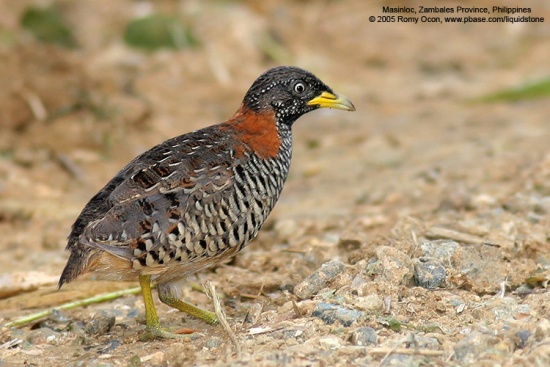Includes: Powell's Buttonquail or Dusky Buttonquail
- Turnix suscitator
Identification
13·5–17·5 (5¼-7 in)
- head boldly patterned
- underparts barred
- legs and feet greyish or yellowish (some subspecies)
Females are brighter and larger than males. They have a black throat and in some subspecies a rufous collar
Variation
The different subspecies vary in size and in patterns and coloration of plumage; especially the ones in the Lesser Sundas seem different from those in the Greater Sundas.
Distribution
Asia: China, Tibet, Nepal, Pakistan, India, Eastern and Western Himalayas, Sri Lanka, Bangladesh, Bhutan, Japan, Taiwan
Southeast Asia: Indochina, Burma, Laos, Vietnam, Cambodia, Thailand, Malaysia, Malay Peninsula, Singapore, Philippines, Borneo, Indonesia, Greater Sundas, Sumatra, Java, Sulawesi, Lesser Sundas, Bali
Taxonomy
Reference [6] notes that the most distinctive subspecies is powelli. This may be treated as a separate species, "Dusky Buttonquail" or "Powell's Buttonquail" (T. powelli).
Subspecies

Photo © by Alok Tewari
Dist. Gurgaon, Haryana, India, 23 August 2016
Clements recognises the following subspecies [1]:
- T. s. taigoor: India
- T. s. leggei: Sri Lanka
- T. s. plumbipes: Nepal, Sikkim and Bangladesh to northern Burma
- T. s. bengalensis: North-eastern India (lower western Bengal)
- T. s. okinavensis: Southern Kyushu Island and Makenoshima Island south to Ryukyu Islands
- T. s. rostratus: Taiwan
- T. s. blakistoni: Burma to southern China, northern Indochina and Hainan Island
- T. s. pallescens: South-central Burma
- T. s. thai: Central Thailand
- T. s. atrogularis: Thai-Malay Peninsula
- T. s. suscitator: Sumatra, Belitung Island and Bangka Island to Java and Bali
- T. s. baweanus: Bawean Island (off Java)
- T. s. fasciatus: Northern Philippines (Luzon to Mindoro, Sibuyan and Masbate)
- T. s. haynaldi: South-western Philippines (Palawan and Calamian Islands)
- T. s. nigrescens: Philippines (Negros, Cebu and Panay)
- T. s. rufilatus: Sulawesi
- T. s. powelli: "Dusky Buttonquail". Lesser Sundas. [back grey without rufous tones. Female with reduced or absent black throat, ventral rufous much reduced; male with very coarse chest barring]
Three additional subspecies: kuiperi, machetes and baweanus are generally considered invalid.[2]
Habitat
Grasslands and scrub. Cultivated areas with crops and sugar cane.
Behaviour
Diet
The diet consists of grass and weed seeds, green shoots and invertebrates.
Breeding
The female builds a grass-lined ground nest, in scrub jungle or crops.
The male incubates the 3 or 4, greyish-white eggs, which are heavily speckled with reddish-brown or blackish-purple, and cares for the young. The female may have several different mates during the season.
References
- Clements, J. F., T. S. Schulenberg, M. J. Iliff, D. Roberson, T. A. Fredericks, B. L. Sullivan, and C. L. Wood. 2017. The eBird/Clements checklist of birds of the world: v2017, with updates to August 2017. Downloaded from http://www.birds.cornell.edu/clementschecklist/download/
- Birdforum thread discussing the id of this species
- Avibase
- Handbook of the Birds of the World Alive (retrieved May 2017)
- Wikipedia
- Eaton, JA, B van Balen, NW Brickle, FE Rheindt 2021. Birds of the Indonesian Archipelago (Greater Sundas and Wallacea), Second Edition. Lynx Editions. ISBN978-84-16728-44-2
Recommended Citation
- BirdForum Opus contributors. (2025) Barred Buttonquail. In: BirdForum, the forum for wild birds and birding. Retrieved 17 May 2025 from https://www.birdforum.net/opus/Barred_Buttonquail
External Links
<GSearch checked for 2020 platform.1






